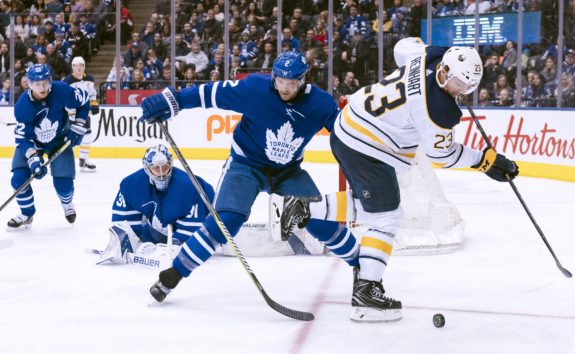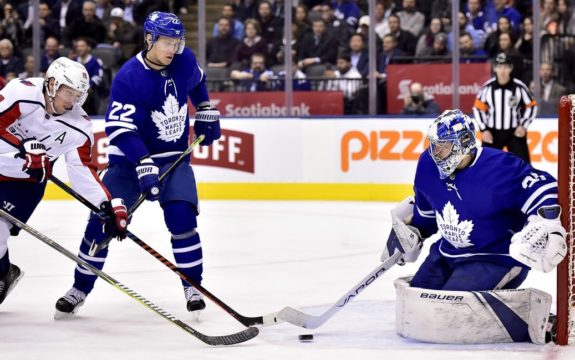About halfway through Friday night’s back-and-forth affair between the Toronto Maple Leafs and Philadelphia Flyers, TSN play-by-play man Gord Miller summed up my thoughts perfectly: “Not sure if it’s a winning recipe in the playoffs, but it’s sure fun to watch.”
There were so many goals in the second period (seven, to be exact), that I’m not entirely sure what the exact score was when he said it. 5-2 Flyers, perhaps? Maybe 5-3? Regardless, the Maple Leafs overcame a three-goal deficit to win the contest 7-6 in regulation, avoiding a third straight loss (they’ve only lost three or more consecutive games once this entire season).
Miller is absolutely right. With all the goals for and all the goals against, Friday night was fun. So was Wednesday, when the Leafs nearly came back from a 5-0 deficit against the Chicago Blackhawks. Monday wasn’t fun, when they were hammered 6-2 by the league-leading Tampa Bay Lightning — but the west-coast swing before that, where the club picked up five of a possible six points and scored 11 goals in three games, was fun. So too was the first game of the month, where Toronto put up five against the division-rival Buffalo Sabres.

It seems the storyline for the Toronto Maple Leafs in March has been goals, goals, and more goals. Their 29 goals this month are tied for the most in the NHL, while their 26 goals against are tied for the second-most. Furthermore, these numbers are more than just a trend. It has been a part of the Maple Leafs identity this season.
The buds lead the NHL in 5-on-5 goals-for with 182. They are middle of the pack in 5-on-5 goals against (tied for 15th with 142), but according to Hockey Reference, their expected goals against (xGA) at 5-on-5 is 164.1.
What does this mean? It means they’ve allowed a ton of chances against and would have a less favourable goal differential if they weren’t bailed out by goaltender Frederik Andersen so often. The Maple Leafs have allowed the fourth-most scoring chances against at 5-on-5 this season (1,684) and Andersen’s 16.72 goals-saved-above-average (GSAA) at 5-on-5 is the best in the NHL.
Related: THW Podcast – Ep. 15 – Maple Leafs, Oilers, Scott Wheeler The Athletic
Obviously, scoring chances for and goals for are good. Nothing to worry about there. Goals and chances against? As Miller said, it’s not the way the Maple Leafs want to play in the post-season. Let’s take a look at what’s going wrong on the defensive side of things.
Too Many Icings
Half of the Flyers six goals on Friday came directly off offensive zone face-offs.
First, it was a Jakub Voracek snipe over the glove of Andersen right off the draw. Then, Sean Couturier beat Auston Matthews on a face-off, that led to a Radko Gudas goal — Robert Hagg ran some pretty good interference on William Nylander as well, which you can see below.
The third goal following an o-zone face-off came with the Flyers’ net empty, when Claude Giroux fired a shot that was tipped in by James van Reimsdyk, giving the former Leaf a hat-trick. The Lightning’s sixth goal on Monday night also came directly off one of their offensive zone face-offs.
Could the inability to win defensive zone face-offs be a problem for the Leafs? Well, the team ranks fourth in the NHL in face-off percentage in their own zone, at 52.6 percent. They have, however, taken the 10th-most defensive zone draws this season, at 1,452. Could there be a reason for all the d-zone face-offs? The tweet below from Rachel Doerrie, who recently worked in the New Jersey Devils analytics department, got me thinking.
https://twitter.com/racheldoerrie/status/1106717042084904960
Thanks to MoreHockeyStats.com, team icing data is publicly available, and surprise, surprise, the Maple Leafs don’t fare very well.
They are second in the NHL in total icings committed in 2018-19 with 361, just two behind the Pittsburgh Penguins. What the site also tracks is how often a team ‘escapes trouble’ after an icing. Depending on how often a goal is scored or a penalty is committed within 30 seconds of an icing, the site uses a ‘good icings percentage’, which is the percentage of time when there were no consequences for icing the puck — no goal or penalty occurred, and another icing also did not occur.
The Maple Leafs ‘good icings’ percentage is fourth-last, at 85.6 percent. So not only do they ice the puck a lot, but their icings tend to lead to either goals, penalties, or (most frequently) another icing, which tires out the group on the ice even more. Keep in mind the site does not track when a goal is scored more than 30 seconds after an icing, which could provide even more insight.
Related – Then and Now: The Maple Leafs All-Time Centres
Lack of Positional Awareness
It was agonizing watching the first period of Monday’s game against the Lightning and Wednesday’s game against the Blackhawks. The Leafs slow starts have certainly factored into the club’s defensive issues, but I want to look at specifically where these issues were occurring instead of when.
Brandon Saad’s goal below, which made it 4-0 for the visitors on Wednesday, epitomized the poor defensive coverage that tends to happen when the Maple Leafs mix standing still with not thinking.
If you pause the video one second in, things appear to be okay. Zaitsev (22) is the first one to the puck and even though the option up the wall has been taken away by Jonathan Toews (19), he appears to have the option of reversing it behind the net to Tyler Ennis (63). Three seconds into the video, Dylan Sikura (65) intercepts the Zaitsev pass. Before the Leafs know what hit them, Saad (20) has the puck on his stick all alone in front of the Leaf goal. He out-waits a sprawling Andersen and then slides it home.
The problem here is a huge lack of positional awareness. First, defencemen Zaitsev and Ron Hainsey (2) are on the same side right from the start of the clip. That’s not ideal. It can be mitigated if a forward realizes that and covers the front of the net. Neither Ennis nor Frederik Gauthier (33) seem to be aware. Nic Petan (19) also doesn’t notice Saad sneak behind him.
What’s worse is how tightly together the five Maple Leafs are. If you pause the video two seconds in (after it’s been intercepted but before Sikura makes the pass), you can see that all five skaters for Toronto are on the same side of the ice and not one of them notices that Saad is all alone in the slot.

This is a worrying trend of getting caught puck-watching far too often. When the Maple Leafs do this, they tend to be closely clumped together and don’t notice players behind them. The Lightning’s third goal on Monday was another example of this, when McDonagh fired a shot from Andersen’s right. The rebound eventually found Tyler Johnson all alone in the crease. Too many Leafs were focused on the initial shot instead of Johnson, who was licking his chops waiting for a rebound. Tavares did a good job trying to tie up Point, but he was out-manned in front two-to-one.
Shayne Gostisbehere’s goal on Friday was another example of puck watching. Yes, it was a 3-on-2 rush, but Ron Hainsey has no business trying to block that Giroux shot. By going down to the ice (and not blocking it), he has taken himself out of the play and completely forgot about Gostisbehere on the other side, who ends up scoring the goal.
How do you fix these situations? Keep your head on a swivel and be smarter positionally without the puck. It’s really that simple.
Maple Leafs D-Core a Turnover Factory
According to NaturalStatTrick.com, four Toronto Maple Leafs defencemen rank in the top-23 for giveaways per 60 minutes at 5-on-5 this season. Muzzin is fifth (3.85), Rielly is ninth (3.46), Hainsey is 22nd (2.89), and Zaitsev is 23rd (2.89). This is out of 144 defencemen that have played at least 800 minutes at 5-on-5. Jake Gardiner also isn’t far behind, at 38th (2.63).

For those who say Muzzin’s poor numbers have more to do with his time playing for the Los Angeles Kings than the Leafs (something I thought as well), it appears the numbers say otherwise. Muzzin averaged 3.31 giveaways/60 in 50 games with the Kings and he has averaged 5.13 giveaways/60 in 22 games with the Leafs.
I would argue it’s okay to have high turnover rates if you can also win the puck back at a high rate. But only Rielly has a takeaway/60 rate above 1.5. Hainsey’s 1.17 takeaways/60 rank 55th, Zaitsev’s 0.7 takeaways/60 rank 116th, and Muzzin’s 0.62 takeaways/60 rank 127th.
Maple Leafs Bad Habits Must End
According to The Athletic, the Maple Leafs have an 100 percent chance of playing the Boston Bruins in the first round of the playoffs (from ‘2018-19 NHL playoff chances and standings projections’, The AthleticNHL, 3/15/19)
Related: Maple Leafs Must Beat Boston Bruins in 1st Round
It’s imperative they get these bad habits out of their system before the two bitter rivals face-off in April for the third time in four seasons. The Bruins allow the second-least scoring chances per 60 minutes in the NHL at 5-on-5, at 23.49. They’ve also been able to get their shot attempts through this season, currently sitting in eighth in unblocked shot attempts per 60 (FF/60), with 44.62.
While they haven’t been finishing at the rate they feel they should (last in 5-on-5 shooting percentage), that can change in a hurry with some luck. If the Maple Leafs don’t tighten things up in their own zone come playoff time, that poor Bruins shooting percentage will even out at the wrong time for the buds.
*All advanced stats in this piece not already directly credited courtesy Natural Stat Trick & NHL.com.